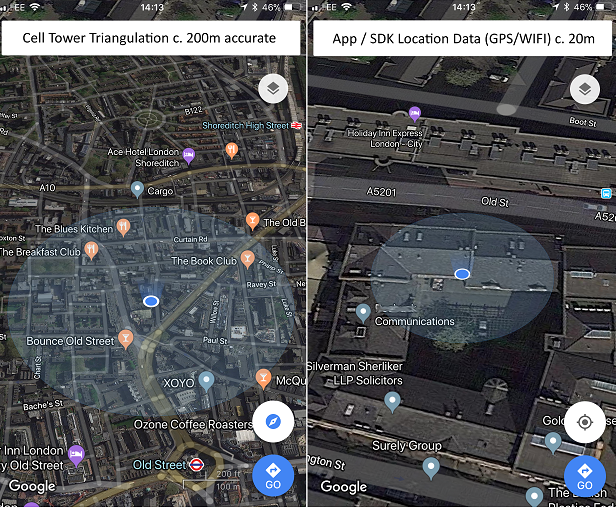With Weve launching its location verification service yesterday, Doug Chisholm, CEO of Rippll, considers the growth in these offerings and what they mean for advertisers and agencies.
 With the rise of interest in digital media transparency that many credit to the very honest words of Marc Pritchard over a year ago there has been a surge in services such as verification and measurement which has pleased me personally both as an ex-media buyer and as an ad-tech entrepreneur.
With the rise of interest in digital media transparency that many credit to the very honest words of Marc Pritchard over a year ago there has been a surge in services such as verification and measurement which has pleased me personally both as an ex-media buyer and as an ad-tech entrepreneur.
As usual, most of the innovation is happening at the cutting edge of digital – i.e. mobile – including all the car/home/office/wrist technologies, all of which pour off huge amounts of valuable location data signals.
The latest mobile transparency service to become available to advertisers is the location verification service from Weve, aptly named Weve Locate, which aims to help advertisers identify accurate location data. This should be a really valuable asset for media agencies if used correctly.
This follows on nicely from the pioneering work of Jide Sobo at MEC last spring, where he used our own Location Verification Service to compare the accuracy of all the location vendors MEC works with. The choice of Rippll was mainly down to our independent positioning – we dont sell campaigns or audiences, and we have unique location data coming directly from apps which provide the most accurate location signals, and also measure how long a consumer was at the location, even when the apps are closed.
Following that verification study, Placecast launched a similar verification service in the US last summer, using telco data from Sprint, and now we have Weve launching a telco-based solution in the UK.
Large data sets
The thing I really like about telcos joining this movement is that they have very large data sets up and down the country, and so can offer this service beyond the usual big cities like London and Manchester where the MEC study was focused.
Also,telcos should be able to further verify demographic data in an anonymised fashion, which I predict will become the next big trend in digital as media agencies begin to ask all media owners (including Facebook and Google) to offer third-party data verification that they are getting what they say they are when planning data-driven campaigns.
There is one point however that I think needs some clarification, and that is the idea that telco location data is somehow more accurate that app location data; this is simply false.
 We have all seen how a mobile app like Google Maps starts positioning your location on a map with a large blue circle which is the triangulation of the nearest cell towers, which is what telcos offer, and is typically accurate to hundreds of meters (about 200m in the screenshot of my handset here in Old Street, London). Apps have access to the GPS chip and wi-fi triangulation, which typically offer accuracy of 1-30 metres (about 20m in the screenshot of my handset here in Old Street). This is precisely why MEC chose to use app data to verify other forms of data (including cell tower), and not the other way round.
We have all seen how a mobile app like Google Maps starts positioning your location on a map with a large blue circle which is the triangulation of the nearest cell towers, which is what telcos offer, and is typically accurate to hundreds of meters (about 200m in the screenshot of my handset here in Old Street, London). Apps have access to the GPS chip and wi-fi triangulation, which typically offer accuracy of 1-30 metres (about 20m in the screenshot of my handset here in Old Street). This is precisely why MEC chose to use app data to verify other forms of data (including cell tower), and not the other way round.
But this is a good thing, as agencies now have choice and competition. They can choose to use telco solutions to verify if data is coming from the right city, and then use app data (also known as SDK data where a Software Development Kit from a vendor sits inside an app), to verify if the data is coming from the right store or venue.
They can choose to use telco data to verify if data comes from one large part of a city or another and then use app data to check if the user was in a particular store for long enough to belong to a given Audience Segment. Also, it follows that the scale of data telcos have means they may well may be able to offer more cost-effective solutions than app data vendors in situations where accuracy isn’t as important as reach.
The knock-on effect of these innovative new transparency services is that agencies have started asking questions of vendors that remove more wastage and hence improve performance. The fact that it took major advertising groups to call time on the opaqueness is perhaps a little surprising, given that increasing transparency and removing bad data/inventory naturally boosts performance.
However, you have to bear in mind that such transparency has the awkward side-effect of reducing reach, which can be hard for an agency to explain to an advertiser used to the intoxicating numbers that Facebook and Google have hooked them on, so its a bit of a Catch 22 until advertisers accept that more transparency means less reach and smaller, more focused digital campaigns.
It may well be these exact verification services that help agencies shine more light on the industry and hence explain properly to advertisers that no, there are not 30m unique users standing 10m away from your stores right now with a location-based app waiting to see your ads… however, just a small amount of well-planned location-based ads will very likely boost your test drives and repeat supermarket visits very cost effectively, so let’s make sure we educate advertisers properly about the power of location and what it can and cant do.
















